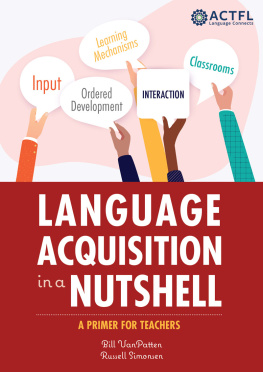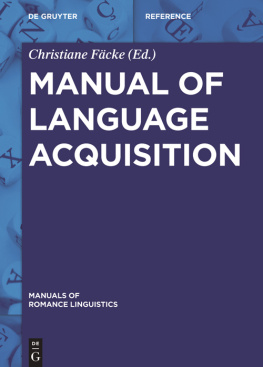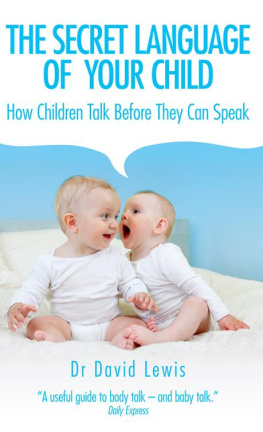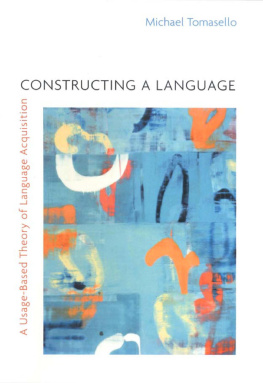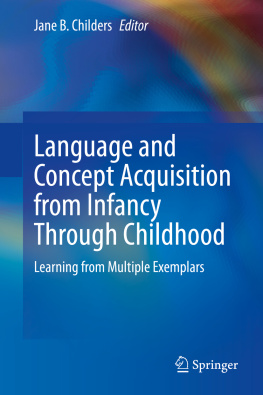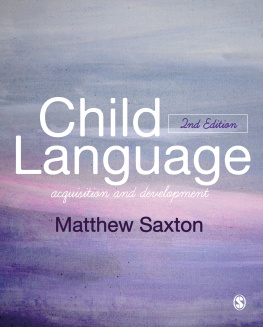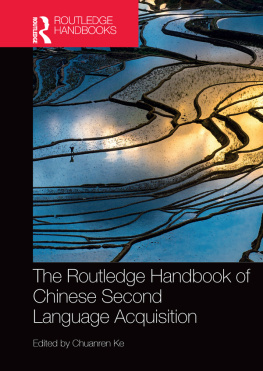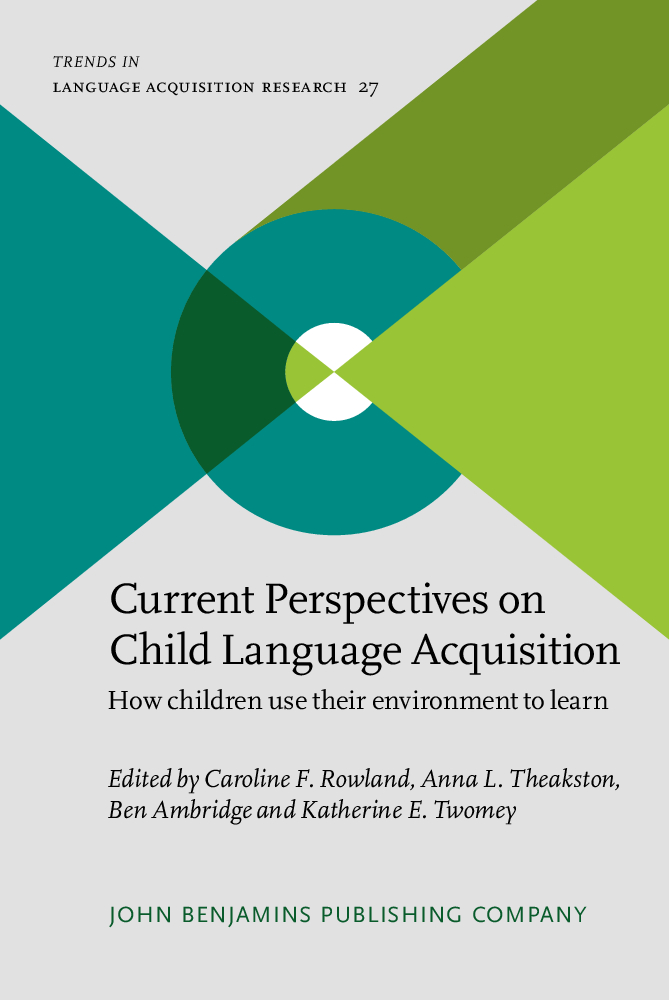

Current perspectives on child language acquisition
How children use their environment to learn
Caroline F. Rowland , Anna L. Theakston , Ben Ambridge & Katherine E. Twomey
doi: 10.1075/tilar.27
ISBN: 978 90 272 6100 7 (ebook)
Cataloging-in-Publication Data available from Library of Congress:
LCCN 2020015564
2020 John Benjamins B.V.
No part of this book may be reproduced in any form, by print, photoprint, microfilm, or any other means, without written permission from the publisher.
John Benjamins Publishing Company https://benjamins.com
John Benjamins Publishing Company
Amsterdam/Philadelphia
Foreword
Michael Tomasello Duke University
This volume is dedicated to Elena Lieven. To review Elena Lievens career is to review the history of the modern study of child language acquisition. She was there, as a graduate student at Cambridge, for the initial meeting of the International Association for the Study of Child Language (IASCL) in 1970. She was there, in the UK, at the founding of the Journal of Child Language (JCL) in 1974 at the University of Manchester. In 1979, she took up her post in the Department of Psychology at the University of Manchester, which she still holds today, as Professor. She was editor of JCL from 1996 to 2005, and president of IASCL from 2008 to 2011. No one has played a more central role in the field from its founding until today than Elena Lieven.
From the beginning, Elena felt deeply in her bones based on extensive observations of many different children learning to talk that theoretical accounts in terms of innate linguistic universals were missing a vital part of the process: individual and cultural variation. Her influential early papers thus focused on such things as variation in adults speech to children, variation in childrens word learning, and variation in childrens grammatical development. And she did fieldwork in New Guinea in the 1970s as well, providing the experiential basis for several important chapters on cross-linguistic and cross-cultural variation in language acquisition, most importantly her seminal chapter in the Slobin cross-linguistic volume in 1997. She continues her cross-cultural fieldwork to this day, for example, in her recent study of Nepalese childrens acquisition of Chintang. And most important for our subsequent work together, and also in opposition to innate universals, she also published during this time in collaboration with her students Julian Pine, Anna Theakston, Caroline Rowland, and others important studies on the lexically-based nature of childrens early grammatical productions.
When I was asked to found a department of developmental and comparative psychology at the Max Planck Institute for Evolutionary Anthropology in Leipzig, Germany, the first call I made was to Elena Lieven. We sat on the lawn at UC Berkeley scheming how we could redirect the field from a focus on innate formal grammars to a focus on childrens active construction of a language from their social and linguistic interactions with others. This change of focus was not only empirically responsible, but also dictated by Elenas political consciousness an important part of her personal identity for all her life in which one must never underestimate the creative power of individuals to learn and to change and to express themselves.
We may not have reached all of our ambitious goals in Leipzig, but we made important scientific progress. Elena ran our dense database project, both in Germany and England, leading to a number of important empirical papers as well as a number of dense corpora that were contributed to the child language data exchange system (CHILDES). She was also leader of the studies using the traceback method on these dense corpora, in which she showed that childrens progress in constructing a grammar occurs over many and varied daily interactions in very small incremental steps. During this time, she was also director of the Max Planck Child Study Center at the University of Manchester, supervising a number of students Ben Ambridge, Daniele Matthews, Evan Kidd, Paul Ibbotson, and Thea Cameron-Faulkner among them and publishing important papers on such things as structural priming as a way of investigating young childrens grammatical development, and the structure of the linguistic input that children hear as characterized in terms of sentence-level constructions. After leaving her fulltime position at the Max Planck, Elena returned fulltime to the University of Manchester as one of the directors of the generously funded, multi-institution consortium, LuCiD, to intensify and expand her unceasing attempts to understand the many mysteries of child language acquisition.
The students and colleagues whom Elena has influenced in one or another fashion are many and varied. All will attest to her inspiration as both mentor and friend. Her influence is so great because she is a scholar with a laser beam focus on the most important questions, and her unbounded enthusiasm and energy are highly contagious. But at the same time she never loses sight of the wider, more humane dimensions of the scientific enterprise, and of life in the modern world in general. She never fails to attend to even the most struggling of students, and to support them and show them respect as human beings. Her deep and abiding influence on the field of child language acquisition will live long, not just in her important empirical and theoretical contributions, but in her many academic progeny as well.
Elenas influence on me has been no less profound. We were the closest of partners in building the department in Leipzig, and her sharp and wise judgments played an essential role in the departments final shape. In terms of science, she was and is the absolutely best discussant one could imagine for sorting through difficult issues and boiling them down to first principles. She is an absolutely superb editor, and always an enthusiastic and perspicacious participant and even organizer of seminars. When it looked like I was straying too far afield, she often helped me to refocus on the most important things, especially and always on the indispensability of language in human experience. I should note, however, that she failed to influence me in calling a sweater a jumper or in pronouncing the word tomato like the queen or in forsaking those adorable but language-less chimps.
The constant throughout even across oceans was and is our friendship, which was mainly forged in the formative years of the department in Leipzig. Most often, we were quite literally the only adults in the room (the others being students about half our age), and as strangers in a strange but wonderful new land we bonded via our attempts to master the German language, the German cuisine, and, most comically, the German bureaucracy in its various and sundry guises. (I am thinking especially of her dealings with the authorities as she attempted to register her British car with its steering wheel on the falsch side of the car.) We were a good team for a pretty good while, I think, and accomplished some good things. This volume is a tribute to one of the, if not the, most important scholars in the modern study of child language acquisition and I raise my glass (of sparkling water) to her.
Introduction
Ben Ambridge , Caroline F. Rowland , Anna L. Theakston & Katherine E. Twomey
If we were to draw a family tree of child language acquisition researchers (or at least of the usage-based branch), Elena Lieven would occupy the position of Mitochondrial Eve. It is therefore fitting that almost all of the chapters in this volume were written by one of Elenas (post)doctoral students, one of their (post)doctoral students, or even one of
Next page

